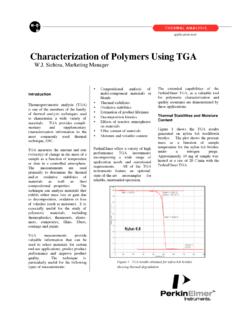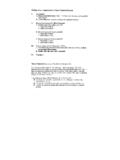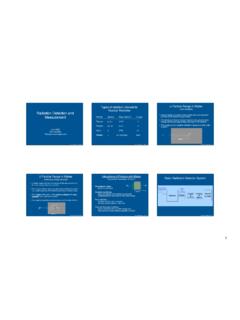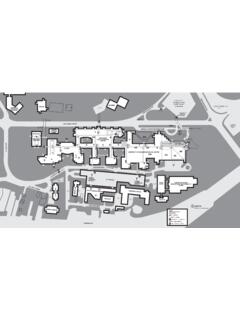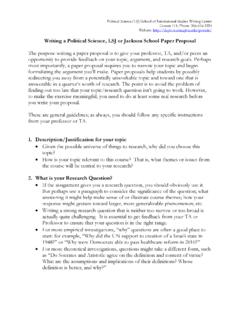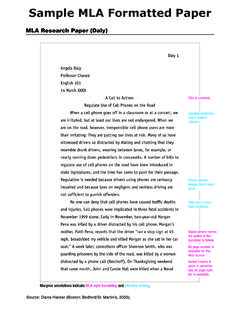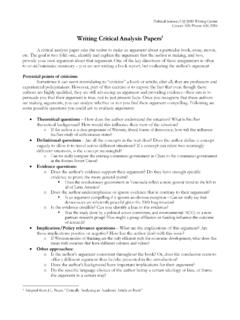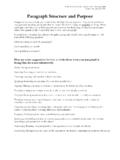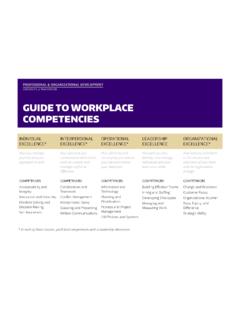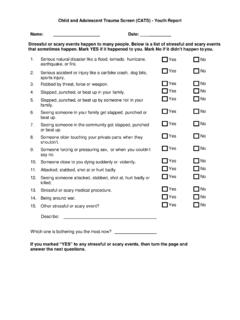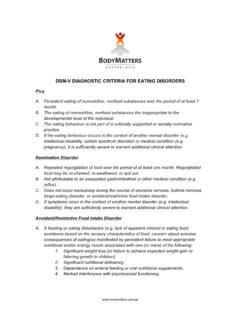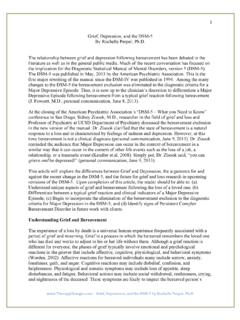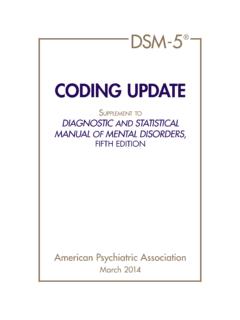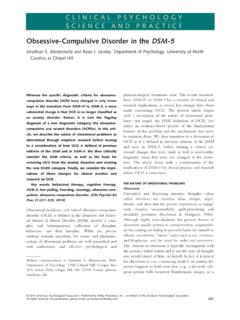Transcription of DSM 5 AUTISM SPECTRUM DISORDER - University of …
1 DSM 5 autism spectrum disorder GUIDELINES & CRITERIA EXEMPLARS eneral Guidelines G One example of a specific criterion may not be sufficient to assign the criterion as being present. o Is the example behavior clearly atypical? o Is the example behavior present across multiple contexts? o Distinguish between behaviors that are clearly atypical and present across multiple contexts, versus behaviors that are on the borderline of being atypical or rarely occur/occur in only one context. For example, while toe walking may be an example of criterion B1, it may not be sufficient by itself to assign the criterion if there is a physical explanation for the behavior (and thus not clearly atypical) and/or if it occurs only in one context ( at the beach when barefoot in the sand).
2 By contrast, a preoccupation with lawnmowers that involves obsessively drawing lawnmowers, seeking out lawnmowers, and talking about lawnmowers is sufficient to meet criterion B3 even if no other examples exist. This preoccupation is clearly atypical and is present across multiple contexts. Avoid using the exact same behavioral exemplar to satisfy two criteria. o Some behaviors may appear to satisfy multiple DSM 5 criteria. It is the responsibility of the clinician to decide where the behavior is best represented. For example, repetitively putting hands over ears may satisfy B1 because it is a repetitive motor movement, or it may be considered under B4 because it represents an adverse reaction to sounds. o Some behaviors are multi faceted and may satisfy multiple DSM 5 criteria.
3 For example, a child who is obsessed with string and insists on always carrying string with him at all times may meet criteria for B3 due to a strong attachment to an unusual object. If the same child also frequently waves string in front of his face and watches it flop up and down, then B4 should also be considered due to the visual sensory aspect of this behavior. Behaviors that are not currently present may be considered. o A behavior that only occurred in the past may be sufficient to assign a criterion. o It is important to consider whether a behavior that occurred in the past is atypical for developmental norms ( handflapping should not be counted if it only occurred from 6 9 months of age). Everything is subject to change. o The final publication of the DSM 5 (May 2013) may provide more guidance on the number of behavioral exemplars required.
4 O The number of required criteria may change. o Major changes SM 5 Criteria for ASD With Examples D A. PERSISTENT DEFICITS IN SOCIAL COMMUNICATION AND SOCIAL INTERACTION ACROSS CONTEXTS, NOT ACCOUNTED FOR BY GENERAL DEVELOPMENTAL DELAYS, AND MANIFEST BY 3 OF 3 SYMPTOMS: A1. Deficits in social emotional reciprocity; ranging from abnormal social approach and failure of normal back and forth conversation through reduced sharing of interests, emotions, and affect and response to total lack of initiation of social interaction. Abnormal social approach o Unusual social initiations ( intrusive touching; licking of others) Laura Carpenter, PhD February 2013 A1 reflects problems with social initiation and response o Use of others as tools Failure of normal back and forth conversation o Poor pragmatic/social use of language ( does not clarify if not understood.)
5 Does not provide background information) o Failure to respond when name called or when spoken directly to o Does not initiate conversation o One sided conversations/monologues/tangential speech Reduced sharing of interests o Doesn t share o Lack of showing, bringing, or pointing out objects of interest to other people o Impairments in joint attention (both initiating and responding) Reduced sharing of emotions/affect o Lack of responsive social smile (note: the focus here is on the response to another person s smile; other aspects of emotional expression should be considered under A2). o Failure to share enjoyment, excitement, or achievements with others o Failure to respond to praise o Does not show pleasure in social interactions o Failure to offer comfort to others o Indifference/aversion to physical contact and affection Lack of initiation of social interaction o Only initiates to get help; limited social initiations Poor social imitation o Failure to engage in simple social games A2.
6 Deficits in nonverbal communicative behaviors used for social interaction; ranging from poorly integrated verbal and nonverbal communication, through abnormalities in eye contact and body language, or deficits in understanding and use of nonverbal communication, to total lack of facial expression or gestures. A2 reflects problems with non verbal communication Impairments in social use of eye contact Impairment in the use and understanding of body postures ( facing away from a listener) Impairment in the use and understanding of gestures ( pointing, waving, nodding/shaking head) Abnormal volume, pitch, intonation, rate, rhythm, stress, prosody or volume in speech Abnormalities in use and understanding of affect (note: responsive social smile should be considered under A1, while affect that is inappropriate for the context should be considered under A3) o Impairment in the use of facial expressions (may be limited or exaggerated) o Lack of warm, joyful expressions directed at others o Limited communication of own affect (inability to convey a range of emotions via words, expressions, tone of voice, gestures) o Inability to recognize or interpret other s nonverbal expressions Lack of coordinated verbal and nonverbal communication ( inability to coordinate eye contact or body language with words) Lack of coordinated non verbal communication ( inability to coordinate eye contact with gestures) A3.
7 Deficits in developing and maintaining relationships, appropriate to developmental level (beyond those with caregivers); ranging from difficulties adjusting behavior to suit different social contexts through difficulties in sharing imaginative play and in making friends to an apparent absence of interest in people Deficits in developing and maintaining relationships, appropriate to developmental level Lack of theory of mind ; inability to take another person s perspective (CA 4 years) Laura Carpenter, PhD February 2013 Difficulties adjusting behavior to suit social contexts Does not notice another person s lack of interest in an activity lack of response to contextual cues ( social cues from others indicating a change in behavior is implicitly requested) Inappropriate expressions of emotion (laughing or smiling out of context) (note: other abnormalities in the use and understanding of emotion should be considered under A2) Unaware of social conventions/appropriate social behavior.
8 Asks socially inappropriate questions or makes socially inappropriate statements Does not notice another s distress or disinterest Does not recognize when not welcome in a play or conversational setting Limited recognition of social emotions (does not notice when he or she is being teased; does not notice how his or her behavior impacts others emotionally) Difficulties in sharing imaginative play (Note: solitary imaginative play/role playing is NOT captured here) Lack of imaginative play with peers, including social role playing (>4 years developmental age) Difficulties in making friends Does not try to establish friendships Does not have preferred friends Lack of cooperative play (over 24 months developmental age); parallel play only Unaware of being teased or ridiculed by other children Does not play in groups of children Does not play with children his/her age or developmental level (only older/younger) Has an interest in friendship but lacks understanding of the conventions of social interaction ( extremely directive or rigid; overly passive) Does not respond to the social approaches of other children Absence of interest in others Lack of interest in peers Withdrawn; aloof; in own world Does not try to attract the attention of others Limited interest in others; Unaware or oblivious to children or adults Limited interaction with others Prefers solitary activities B1.
9 Stereotyped or repetitive speech, motor movements, or use of objects; (such as simple motor stereotypies, echolalia, repetitive use of objects, or idiosyncratic phrases). B. RESTRICTED, REPETITIVE PATTERNS OF BEHAVIOR, INTERESTS, OR ACTIVITIES AS MANIFESTED BY AT LEAST 2 OF 4 SYMPTOMS: A3 reflects problems with social awareness and insight, as well as with the broader concept of social relationships Stereotyped or repetitive speech o Pedantic speech or unusually formal language (child speaks like an adult or little professor ) B1 includes atypical speech, movements, and play o Echolalia (immediate or delayed); may include repetition of words, phrases, or more extensive songs or dialog o Jargon or gibberish (mature jargoning after developmental age of 24 months) o Use of rote language o Idiosyncratic or metaphorical language (language that has meaning only to those familiar with the individual s communication style); neologisms o Pronoun reversal (for example, You for I.)
10 Not just mixing up gender pronouns) o Refers to self by own name (does not use I ) o Perservative language (note: for perseveration on a specific topic, consider B3) Laura Carpenter, PhD February 2013 B3 includes preoccupations with objects or topics o Repetitive vocalizations such as repetitive guttural sounds, intonational noise making, unusual squealing, repetitive humming Stereotyped or repetitive motor movements o Repetitive hand movements ( , clapping, finger flicking, flapping, twisting) o Stereotyped or complex whole body movements ( , foot to foot rocking, dipping, & swaying; spinning) o Abnormalities of posture ( , toe walking; full body posturing) o Intense body tensing o Unusual facial grimacing o Excessive teeth grinding o Repetitively puts hands over ears (note: if response to sounds, consider B4) o Perseverative or repetitive action / play / behavior (note: if 2 or more components, then it is a routine and should be considered under B2) o Repetitive picking (unless clear tactile sensory component, then consider B4) Stereotyped or repetitive use of objects o Nonfunctional play with objects (waving sticks; dropping items) o Lines up toys or objects o Repetitively opens and closes doors o Repetitively turns lights on and off B2.
